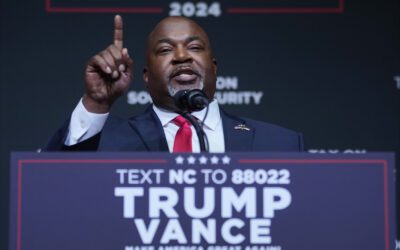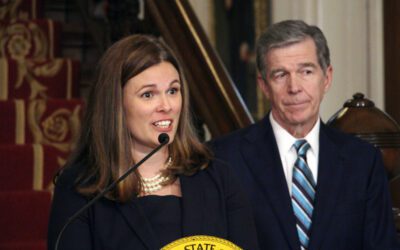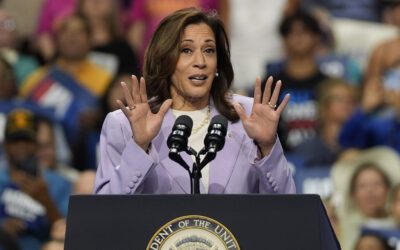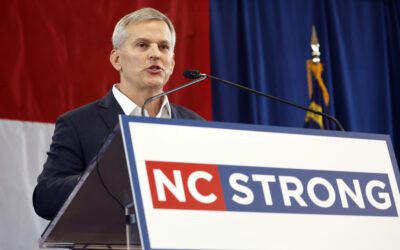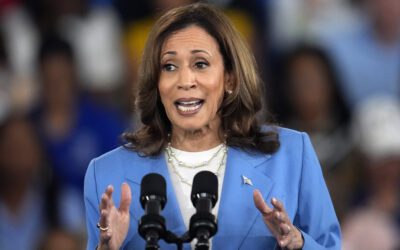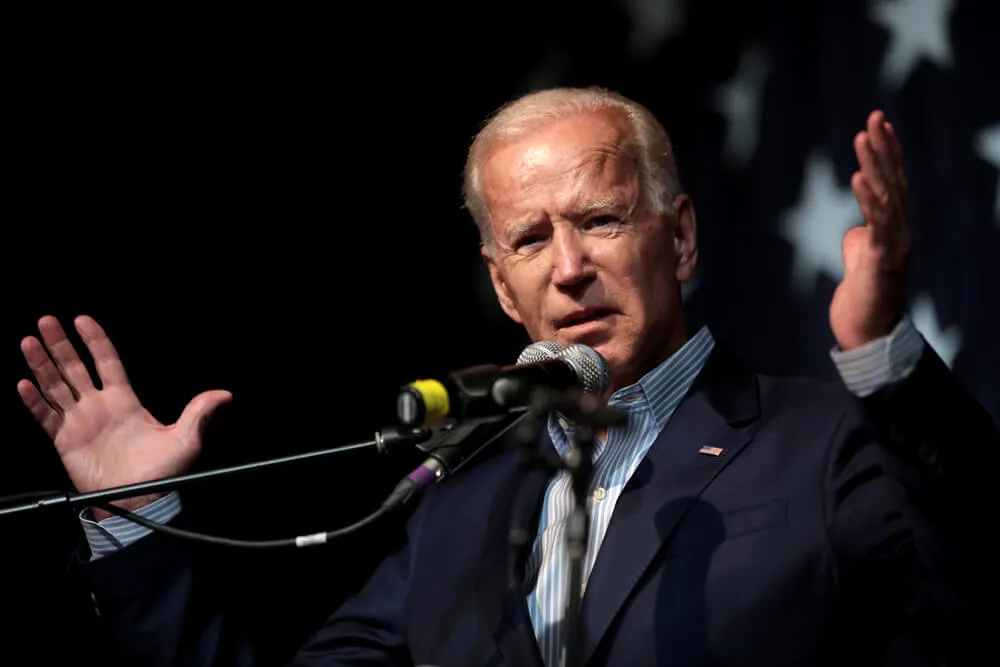
Democratic presidential nominee Joe Biden in 2019 in Iowa. The presidential candidate was in North Carolina Wednesday to talk raising the minimum wage and economic justice, particularly for Black Americans. (Image via Shutterstock)
As party conventions heat up, Joe Biden and President Donald Trump offer starkly different tax plans for the country.
When he graduated from the University of Chicago’s law school, Richard Schmalbeck went to work for Republicans, beginning in then-President Gerald Ford’s Office of Management and Budget.
He was a Republican for the next 30 years, but became an independent during George W. Bush’s second term.
“I’m a raging moderate,” he says, “and they just don’t seem to be quite as welcome in the Republican Party these days.”
Today, he’s an expert in tax policy for Duke University’s law school. And with Republicans zeroing in on taxes in their attacks against Democrats and Joe Biden during last week’s Democratic National Convention, Schmalbeck told Cardinal & Pine that the two major parties are offering two starkly different plans for the country.
“Republican tax proposals have been more business friendly,” he says. “Democrats have been much more concerned with middle-income taxpayers.”
Indeed, Schmalbeck says a change in the corporate tax rate might be one of the biggest impacts of a Joe Biden presidency.
“It’s just hard to overstate the importance of a 40% cut in the corporate tax rate,” Schmalbeck said this week, referring to the GOP’s reduction in taxes on business profits from 35% to 21% during President Donald Trump’s first year in office. “That’s really quite a striking rate cut.”
Biden proposes to bring the corporate rate back up to 28%, and Schmalbeck says that would put it more in line with rates in other industrialized countries.
Schmalbeck is one of several tax policy experts and North Carolina residents who spoke to Cardinal & Pine in recent days as the presidential race turned to an economy reeling from the coronavirus pandemic, at least partially because of misleading ads targeting Biden.
In addition to Biden’s plan for the corporate tax rate, the Democratic presidential nominee has indicated he would increase child and dependent care tax credits, raise the top individual income tax rate to 39.6% (up from 37%) and tax capital gains as ordinary income for earners with more than $1 million in income.
Biden released many of his proposals in a summary of a joint task force with former presidential rival Bernie Sanders in July.
As CNBC reported last month, the task force indicated it would use taxes “as a tool to address extreme concentrations of income and wealth inequality. A guiding principle across our tax agenda is that the wealthiest Americans can shoulder more of the tax burden, including in particular by making investors pay the same tax rates as workers and bringing an end to expensive and unproductive tax loopholes.”
There’s no question that Trump’s corporate rate-cut incentivized investment, offering some lift to the stock market during the pandemic, Schmalbeck says. “If you raise the taxes on business expansion, I think you can expect to get a little bit less of it,” he said.
“But so what?” added Schmalbeck. Other economic measures, like GDP, employment and interest rates all have a bigger impact on a greater number of Americans than does the stock market, he said.
“Anything that taxes wealth taxes those who have it and bears much less heavily on those who don’t,” Schmalbeck said. “The stock market basically reflects the expectations of the investing class, which is really a small part of the economy, though it’s an important one because they’re the ones that provide the capital.”
How does the US stack up against other countries?
Combining state and federal tax rates on corporations, the net rate in the U.S. is below average, and at 1.1%, the share of U.S. corporate taxes as a percentage of the gross domestic product is only about one-third of the average of other G7 nations.
“The U.S. is a low-tax country compared to other Western countries,” said Durham resident Meg Wiehe, deputy executive director with the Washington-based Institute for Taxation and Economic Policy. Even at 35%, she said U.S. tax law was and is full of loopholes.
“Because there are so many exceptions, many corporations are paying nowhere close to that 21%,” she said. “At the end of the day, barely any corporation was paying anywhere close to that 35%.”
UNC-Chapel Hill accounting professor Jeffery Hoopes, research director at the UNC Tax Center at the Kenan-Flagler Business School, says Biden’s proposal might be a symbolic gesture.
“Biden wants to take it up to somewhere in the middle, lower than it was under Obama/Biden, but higher than Trump,” Hoopes said.
Wiehe said Biden would ask more from those earning above $400,000 in order to help the working class and to invest in national infrastructure.
“You’re really talking about impacting the top 1% of the country,” she said. “It’s definitely a start — to really equalize how we tax wealth vs. work. The centerpiece of the Biden tax plan is just the bigger picture idea of building a more equitable tax code that works for working people and not just the wealthy and corporations.”
Wiehe said trickle-down economics haven’t panned out, because investment doesn’t always create more jobs, whereas working and middle class people tend to spend most of their income, stimulating the economy.
“That supply-side rhetoric is really just a way to reduce spending in low-income communities,” she said. “For some people. It’s beyond ideology. It’s like gospel.”
‘A lot of smoke and mirrors’

Deep cuts to corporate taxes are especially burdensome to working people, because those taxes are paid by investors both nationally and globally, meaning to cut them is in part to shift the relative tax burden from foreign money-makers to American workers who have far less disposable income.
“Capital moves globally and pretty fluidly,” said Schmalbeck. “There is a sense in which the U.S. corporate tax rate is kind of a tax on the whole world.”
“We gave more tax cuts to foreign investors than we did to the entire bottom 60% of the taxpayers,” said Wiehe.
Trump’s tax cuts lowered income tax bills by 10 to 15% for lower- and middle-income earners, but, overall, 50% of the benefits went to the top 5% of taxpayers.
“There was a lot of smoke and mirrors,” Wiehe said. “There was a lot of optics and a lot of rhetoric around helping middle and working people that were being talked about that just were not true.”
The cuts also helped to force the federal government to borrow nearly $4 trillion in 2020 in order to respond to the COVID-19 pandemic.
Since Trump took office, the federal budget deficit has climbed from just under $600 billion in 2016 to an estimated $3.7 trillion this year. Between 2009 and 2016, the Obama administration had trimmed the deficit from its high of $1.4 trillion as the country faced the Great Recession. But by 2019, the Trump administration had brought it back near $1 trillion, and the Congressional Budget Office is predicting more than $2 trillion in 2021.
Biden’s tax hikes would raise an extra $3.5 trillion over the next decade, but various estimates suggest he would spend every bit of that and more, including $2 trillion on clean energy and $1.5 trillion for reinvestment in distressed factory towns and subsidies for child- and elder-care
Wiehe acknowledged that COVID-19 has changed the calculations for what will be possible in the short-term, but she questioned why Senate Republicans are using the deficit as an excuse for stalling on further pandemic relief spending.
“They didn’t blink an eyelash when they passed a $2 trillion tax cut,” she said. “They’re using this definite problem now to be able to not make really critical investments.”

Op-Ed: Studying the Holocaust remains vital to ensuring it never happens again
International Holocaust Day will be observed on January 27, 2024. This day commemorates the liberation of the Auschwitz concentration camp by the...

VIDEO: How Rural Broadband Is Coming to This North Carolina County
More than 1.1 million North Carolinians lack access to high-speed internet, a necessity of the modern economy. In Warren County, help is on the way,...

VIDEO: Sampson County puts Biden’s promise to boost rural infrastructure to the test
Locals in this rural NC county say their water and air is polluted by a PFAS-contaminated landfill, massive hog and poultry farms, and industrial...

VIDEO: Sampson County puts Biden’s promise to boost rural infrastructure to the test
Locals in this rural NC county say their water and air is polluted by a PFAS-contaminated landfill, massive hog and poultry farms, and industrial...

Mold and classes in trailers: Inadequate funding for schools is hurting NC communities
Schools across the state are dealing with dilapidated classrooms and buildings in need of significant repair or a total rebuild due to a lack of...


